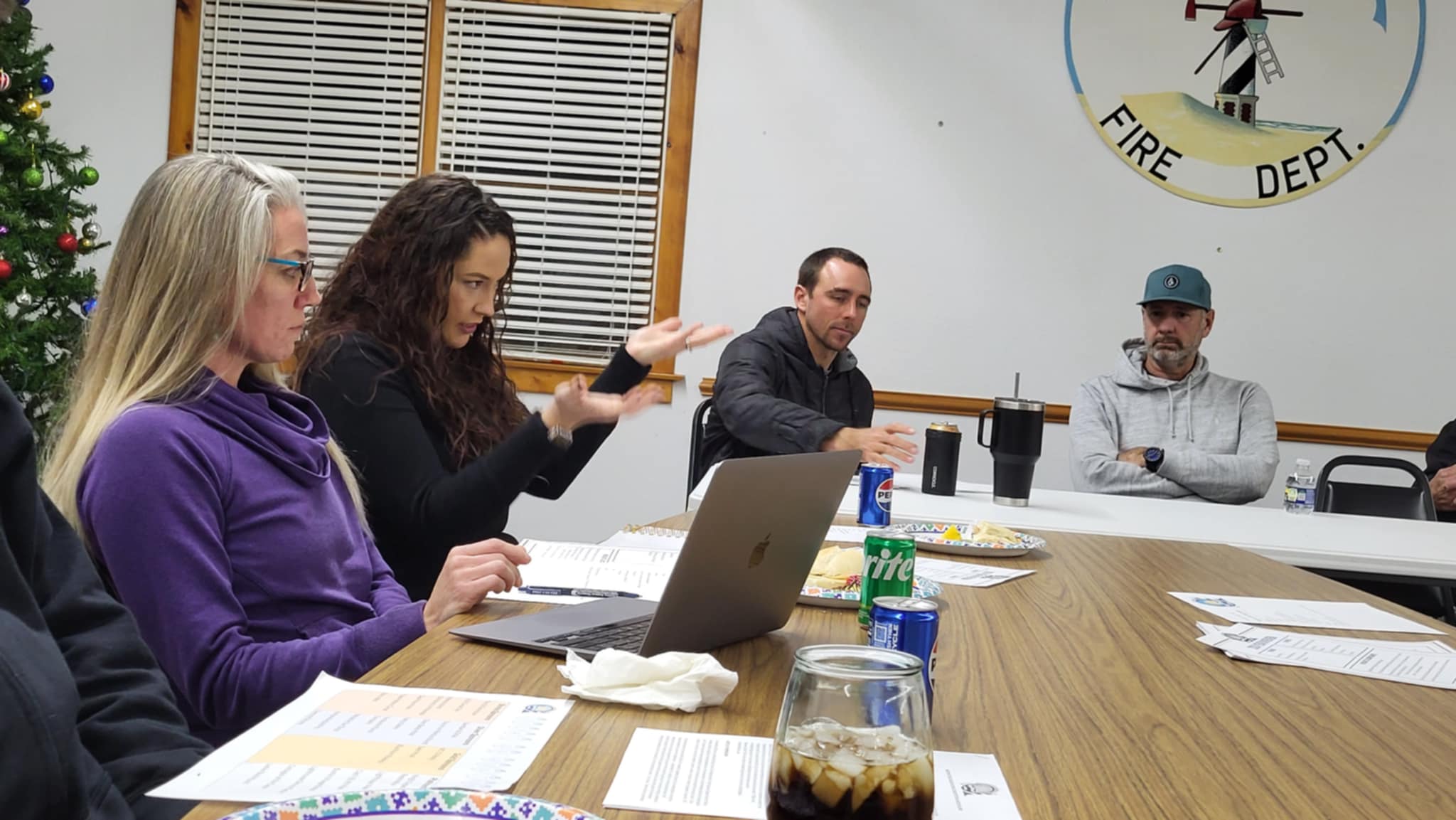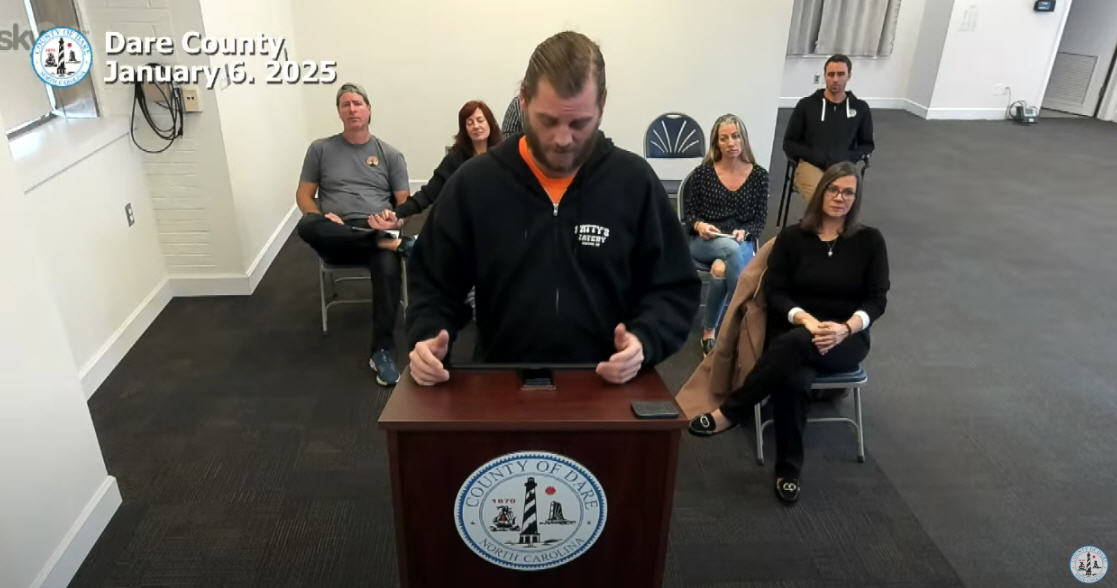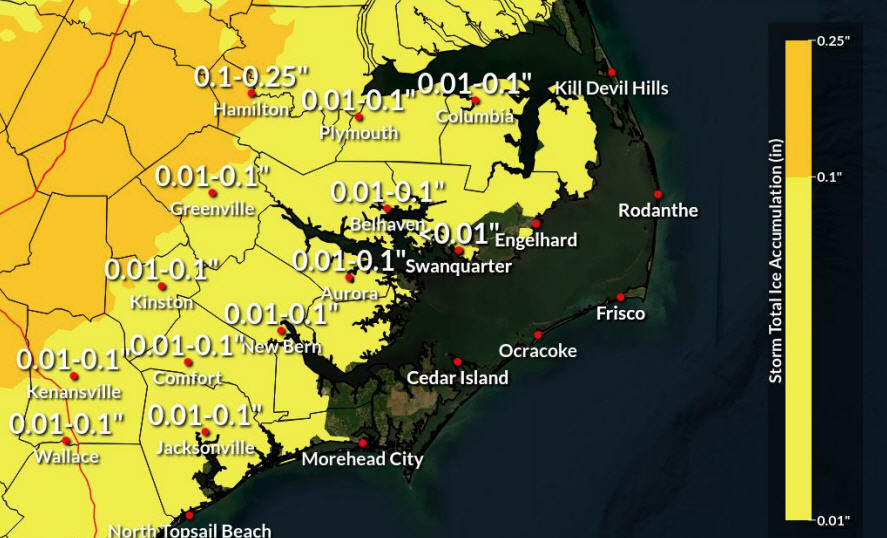Commissioners hear about bridges, dredging, and ferry tolling
By IRENE NOLAN
Transportation issues topped the agenda at the Dare County Board of Commissioners meeting on Monday, Feb. 1.
Among the long list of items on the agenda were updates on the Bonner Bridge replacement and other bridges on northern Hatteras Island, dredging in Hatteras Inlet, and ferry tolling.
Jerry Jennings, North Carolina Department of Transportation Division 1 Engineer, gave the commissioners a briefing on bridge replacements.
BONNER BRIDGE REPLACEMENT
Jennings said the contract was originally awarded to the design-build team of PCL Civil Constructors and HDR Engineering in 2011 for $215.8 million. The team will still design and build the Bonner replacement at a cost that has risen to $246 million because of delays caused by legal challenges.
The contractors are already gearing up, Jennings said, and construction is expected to begin in March. The current schedule, he said, calls for the new bridge to be open for traffic by November 2018. The project, including the demolition of the old bridge, is scheduled for completion in September 2019.
The new structure, Jennings said, would be more durable than the current bridge, ensure safer navigation through Oregon Inlet and perhaps even reduce the amount of dredging needed there, and have fewer problems with scour around the pilings.
Jennings made several comparisons between the old and the new bridge:
The new bridge will be 2.8 miles long, compared to 2.4 miles for the current one.
The new bridge will have fewer bents or pilings to interfere with navigation — 83 compared to 207 on the current bridge.
The new bridge will have seven navigation spans, compared to one on the current bridge. This will allow the channel to migrate more without limiting where vessels pass under the bridge, which may reduce dredging.
The navigation openings on the new bridge will be 291-314 feet, while they are only 130 feet on the current bridge.
The total high-rise length on the new bridge will be 3,550 feet, compared to 502 on the current one.
And, finally, the lifespan of the replacement bridge will be 100 years. The lifespan on the current bridge was 30 years, and it has been exceeded by more than two decades — at great cost to NCDOT.
“There are less pilings in the water, less obstructions for mariners and less scour potential as well,” Jennings told the commissioners.
The replacement bridge calls for many precast concrete elements, the use of stainless reinforcing steel, and high durability concrete to protect against corrosion. The bridge, Jennings said, will have “a more substantial foundation” and deeper pilings to add to its durability and lifespan.
Most of the current bridge will be demolished and the demolition material will be added to several offshore reefs. About 1,200 feet of the bridge will be retained –both as a “fishing pier” and, Jennings said, a “training structure” and will help keep deeper water from migrating south.
No explosives will be used on site to demolish the old bridge to keep debris from falling into the water. The pieces of the old bridge will be moved to another site before demolition.
Jennings also introduced resident engineer Pablo Hernandez, who will be managing the day-to-day details of both the Bonner Bridge replacement and other bridges planned for northern Hatteras Island.
PEA ISLAND INTERIM BRIDGE
Jennings noted that the temporary, 660-foot steel bridge that is now in place at the site of the inlet formed on Pea Island by Hurricane Irene in 2011 will soon be replaced with a sturdier but still temporary structure.
He said that a contract for $79.7 million was awarded to Parsons Construction in November 2013 to build a 2.1 mile permanent bridge on the site. Work was halted on the bridge in September 2014 when NCDOT began negotiating with environmental groups to end the legal challenge to the construction of the Bonner Bridge and the plans for other “hotspots” on Highway 12 — such as the Pea Island Inlet.
The contract with Parsons was cancelled in June 2015 as part of the settlement with the environmental groups. The groups agreed to let NCDOT replace the smaller, steel bridge with a larger temporary bridge, but NCDOT promised to consider other alternatives for a permanent bridge on the location — including a bridge out into Pamlico Sound and away from the wildlife refuge.
A new contract was awarded to T.A. Loving Co. in November 2015 for $14.3 million to build a half-mile long interim concrete structure.
Jennings said the new version of the temporary bridge will be “much more substantial” and is designed to last until there is a long-term solution in the area.
The contractor, he said, is mobilizing, and the bridge is scheduled to be open to traffic in April of 2017. The project will be completed in August 2017.
NORTH RODANTHE BRIDGE
Jennings called the area of the S-curves and Mirlo Beach in north Rodanthe a “historical hotspot.”
He noted that the roadway was reconstructed and sandbags placed after Hurricane Irene in 2011. After Superstorm Sandy in 2012 caused more damage, a beach nourishment project was planned for the area. It was completed in September 2014.
Planning for a long-term solution in the area has been underway for several years, and a preferred alternative was selected in June of last year. That alternative is a 2.5-mile “jug-handle” bridge that will be built out into Pamlico Sound and rejoin Highway 12 just north of Island Convenience in Rodanthe.
Public meetings on the preferred alternative, he said, are planned for this spring with a Record of Decision issued this summer and a contract signed later this year. Jennings said three design-build teams have been shortlisted to build the bridge, which is estimated to cost about $200 million.
Click here to see Jennings’ entire presentation to the Board of Commissioners with graphics and photos.
HATTERAS INLET DREDGING
Jed Dixon, assistant director of NCDOT’s ferry division gave the commissioners an update of the recent dredging project in Hatteras Inlet.
The project opened up each end of a connecting channel between Sloop Channel and the Hatteras Gorge — a passage that is critical for boats to have access to the ocean.
The Ferry Division used the state dredge, Carolina — a pipeline dredge — for the project, which started on Nov. 25 and was finished on Jan. 11 at a cost of $273,000, considerably less than the estimated cost of $452,000.
The county pays one-fourth of the cost from its inlet management fund and the state pays three-fourths.
Allen Burrus noted that captains are still experiencing some problems with shallower water at the east end of the dredge project next to the Gorge. Dixon said that the strong flow of water and currents through the area will open it up more and keep it open.
Dixon also said that 55,000 cubic yards of sand were removed during the project and much of it was or will be used for dune replenishment on north Ocracoke.
He also noted that the state’s new dredge will be ready for operation in April. It is also a pipeline dredge, he said, but is “a nice update from what we have now.”
FERRY TOLLING
The Board of Commissioners slightly softened — but did not change — its stance on ferry tolling.
At its meeting on Monday, the commissioners voted unanimously to support a resolution by Hyde County’s commissioners that the Albemarle Regional Planning Organization delay considering ferry tolls until after the General Assembly explores alternate funding when it meets this spring.
A similar resolution was approved on Jan. 27 at a meeting of the Albemarle RPO in Elizabeth City.
Monday’s approval of the resolution may somewhat mend fences with Dare’s neighbors in Hyde County, which includes Ocracoke.
Back on Oct. 19, the Dare board surprised many observers by approving by a 6-1 vote a resolution recommending that the Albemarle Regional Planning Organization approve ferry tolling — including a toll on the Hatteras-Ocracoke route.
The only commissioner dissenting was Allen Burrus of Hatteras village.
The move surprised and angered Dare’s neighbor, Hyde County, which has opposed tolls, especially on the Hatteras-Ocracoke route, which Hyde officials believe would damage the Ocracoke economy even more than the longer ferry route already has.
The problems stem from a change in how new ferries are funded in the state.
Before Gov. Pat McCrory’s Strategic Transportation Investments Act was passed in 2013, ferries were funded by the legislature in the state budget. The new transportation plan divides the state into 10 regions and gives them a pot of money to finance all transportation needs.
Now funding of ferries, at about $15 million each, must come out of the pot of money allocated to the 11-member Albemarle RPO — which totals just $32 million. Both Hyde and Dare are members of the Albemarle RPO.
The RPO, at its Oct. 21, meeting decided to kick the can down the road and make another attempt to get the legislature to reconsider how it funds new ferries when its meets in a short session next spring.
Both Rep. John Torbett, R-Gaston, and Rep. Paul Tine, U-Kitty Hawk, are in favor of removing ferry replacement from the projects that must be funded by the RPOs and both have promised to work toward that goal when the legislature meets.
Torbett is chairman of the House Select Committee on Strategic Transportation Planning and Long Term Funding Solutions, and he brought members of the committee to Hyde County earlier this week to hear from Ocracokers on their opposition to ferry tolling.
After the Dare board’s October vote in favor of tolling, Commissioner Warren Judge, traveled to a Hyde County board meeting, to apologize for his vote.
On Nov. 16, Hyde County manager came to Manteo to make a personal appeal to the Dare board to reverse or rescind its resolution favoring tolling.
But, by a vote of 5-2, the Dare board turned down Rich’s plea. In favor of changing the board’s stance were Burrus and Judge, the board’s only two Democrats.
At Monday’s meeting, the vote was only in favor of supporting a resolution to wait until the legislature weighs in on funding ferries before the RPO makes a decision on the issue.
Apparently, the resolution favoring tolling still stands.
Commission vice-chairman Wally Overman told the Outer Banks Sentinel that if and when the RPO votes on ferry tolling, Dare County will vote in favor of it. However, he said, the Dare commissioners also favor waiting for the legislature to act.
OTHER BUSINESS
In other business at the board meeting, the commissioners told David Alberg, superintendent of the Monitor National Marine Sanctuary, that they do not favor plans that NOAA is currently considering to expand the sanctuary.
Chairman Bob Woodard read the comments by the board, which are about identical to the comments the board made when the issue was first raised almost five years ago.
“The Dare County Board of Commissioners strongly supports the use of peer-reviewed science to protect the resources, preserve the archaeology, and pursue ongoing research, monitoring, and conservation,” the comments say.
The commissioners encourage NOAA in its education and outreach efforts and call on the agency to expand its utilization of the Graveyard of the Atlantic Museum in Hatteras village.
However, the commissioners said, they “strongly object” to any expansion of the Monitor National Marine Sanctuary.
“Our problem is not with you,” Burrus told Alberg. He said the problem is that “Government organizations today are subject to being hijacked by special interest groups.”
Click here to read an article on NOAA expansion plans, including how to comment and where meetings are planned. One of them will be on Thursday, Feb. 11, from 6 to 9 p.m. at the Graveyard of the Atlantic Museum.
Cick here to read the Board of Commissioners comments on the NOAA expansion plans.
And, the board heard a presentation from Chris Elder, gypsy moth program manager in the North Carolina Department of Agriculture and Consumer Services’ Plant Industry Division.
The division plans to spray an area this spring in Buxton that is heavily invested with gypsy moths.
Last year, the division announced in a letter to property owners and in two public meetings that it planned to eradicate a severe, isolated infestation of the invasive gypsy moth in the Buxton Woods State Reserve area of Buxton and Frisco — an infestation that threatens the maritime forest’s live oak trees with defoliation and eventually death.
“The infestation is intense, but small and very treatable,” said Chris Elder, gypsy moth program manager in the Plant Industry Division.
The division plans to use ground spraying in the most heavily infested area and aerial spraying in a larger area. Elder said the spray will affect only gypsy moths and will not affect humans or other plants or animals. The spraying depends on weather, but will likely happen in early April.
Click here for more information on gypsy moths and the state’s plans.
In the lengthy meeting, the board also approved a wellness program for its employees, voted 4-3 to lease some farmland on the mainland to Sow and Reap LLC, made two changes to its zoning regulations, and approved the Tourism Board’s grant of $20,700 in additional funds to the Soundside event site in Nags Head.
Click here to view a video of the Commissioners’ Feb. 1 meeting. The video will allow you to click on the agenda on the right hand side of the screen and go directly to the discussion you want to hear in the meeting, which began at 9 a.m. and ended about 2 p.m. with a 45-minute lunch break and a shorter morning break.
And click here for the agenda packet, which includes documents for many of the items under discussion.





























